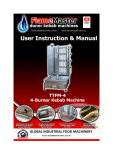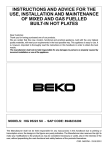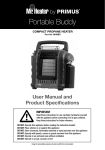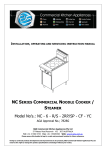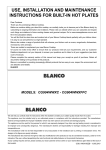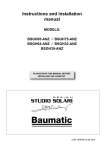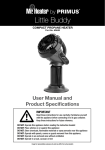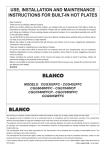Download instAllAtion & opERAtinG instRuctions
Transcript
installation & operating instructions ® RGE 410 RA/RM-2D 822706106 MO-M 0740 INTRODUCTION CONTENTS We are pleased that you have chosen this refrigerator and hope you will derive much satisfaction from using it. The refrigerator is designed for storage of foods and storage of frozen foods and making ice. The refrigerator is ideal for installation in homes, farms, cottages, holiday homes, and chalets or similar. The installation and servicing should only be carried out by an authorized, qualified person and must conform to all relevant national and local regulations. It is important to read through these instructions carefully before using the refrigerator. To ensure good refrigeration and economical operation, the refrigerator must be installed and used as described in these instructions. OPERATING INSTRUCTIONS _ ________________ 4 CONTROLS. . . . . . . . . . . . . . . . . . . . . . . . . . . . . . . . . . 4 STARTING THE REFRIGERATOR . . . . . . . . . . . . . . . . 4 REGULATING THE TEMPERATURE. . . . . . . . . . . . . . 4 FOOD STORAGE. . . . . . . . . . . . . . . . . . . . . . . . . . . . . 4 positioning the storage racks. . . . . . . . . . . . 4 ICE-MAKING. . . . . . . . . . . . . . . . . . . . . . . . . . . . . . . . . 5 DEFROSTING. . . . . . . . . . . . . . . . . . . . . . . . . . . . . . . . 5 CLEANING THE REFRIGERATOR. . . . . . . . . . . . . . . . 5 TRANSIT DAMAGE Inspect the refrigerator for damage. Transit damage must be reported to whoever is responsible for delivery not later than seven days after the refrigerator was delivered. TURNING OFF THE REFRIGERATOR. . . . . . . . . . . . . 5 DATA PLATE MAINTENANCE. . . . . . . . . . . . . . . . . . . . . . . . . . . . . . . 5 iF THE ‘FRIDGE FAILS TO WORK . . . . . . . . . . . . . . . 5 SOME USEFUL HINTS. . . . . . . . . . . . . . . . . . . . . . . . . 5 The data plate is located inside the refrigerator. Since these details will be needed if you have to contact service personnel, it is a good idea to make a note of them here: TECHNICAL DATA. . . . . . . . . . . . . . . . . . . . . . . . . . . . . 5 INSTALLATION INSTRUCTIONS________________ 6 Model designation. . . . . . . . . . . . . . . . . . . . . . . . GENERAL INSTRUCTION . . . . . . . . . . . . . . . . . . . . . . 6 Voltage. . . . . . . . . . . . . . . . . . . . . . . . . . . . . . . . . PLACEMENT OF THE REFRIGERATOR. . . . . . . . . . . 6 LP GAS CONNECTION. . . . . . . . . . . . . . . . . . . . . . . . . 6 Gas pressure. . . . . . . . . . . . . . . . . . . . . . . . . . . . ELECTRICAL CONNECTION . . . . . . . . . . . . . . . . . . . . 7 Product number . . . . . . . . . . . . . . . . . . . . . . . . Lighting. . . . . . . . . . . . . . . . . . . . . . . . . . . . . . . . . . . 7 Serial number. . . . . . . . . . . . . . . . . . . . . . . . . . . OPERATING INSTRUCTIONS 5. Keep the button (C) pressed for a further 10-15 seconds. CONTROLS To terminate gas operation, turn knob (A) to 0. 6. Release the button (C) and check that the flame is alight. Electric operation Set the energy selector (A) to position I. REGULATING THE TEMPERATURE The position number refers to fig. 1. It will take several hours for the refrigerator to reach normal operating temperature. A thermostat controls the temperature of the main compartment of the refrigerator. The thermostat knob (B) should be set at 3-5. If a lower (colder) temperature is desired set the thermostat to a higher figure. FOOD STORAGE Always keep food in closed containers. Never put hot food in the refrigerator; allow it to cool first. Never keep items in the refrigerator that might give off flammable gases. The frozen food compartment is intended for the storage of frozen food and for making ice. It is not suitable for freezing items of food. Never put bottles or cans of fizzy drinks in the frozen food storage compartment as they may burst when freezing. Also don’t give children ice-lollies straight from the frozen food as they could cause frost burns. Most kinds of frozen food can be stored in the frozen food compartment for about a month. This period of time may vary, however, and it is important to follow the instructions on the individual packets. FIG. 1 The refrigerator can be run on either mains electric or LP gas. Changing between these modes of operation is carried out by means of control buttons positioned as shown in fig. 1. The energy selector (A) can be set at either I (= 230 - 240V), (= LP gas) or 0 (= off). positioning the storage racks The refrigerator temperature is controlled by a thermostat (B). Please note that the thermostat has no “off” position. Dismantling/mounting 1. Remove the front and back securing brackets. The refrigerator is fitted with a safety device that automatically shuts off the supply of gas if the flame goes out. The safety device can be opened manually by pressing the button (C). The piezoelectric igniter discharges sparks over the burner when the button (D) is pressed. 2 1 In the flame viewer (E) you can see a blue light when the gas flame is lit. STARTING THE REFRIGERATOR Whilst mobile: • Do not operate the refrigerator on LP gas. • Turn off the gas bottle. 2. Detach the storage rack by moving it to the left (1) and then tilt it up or down (2). Pull rack towards you and remove. The position numbers refer to fig. 1. LP Gas operation 1 After initial installation, servicing, or changing gas cylinders etc., the gas pipes may contain some air, which should be allowed to escape by briefly turning on the refrigerator or other appliances. This will ensure that the flame lights immediately. 1. Make sure that all valves between the gas container and the refrigerator are open. 2 2. Turn the energy selector (A) to position . . Push the button (C) in until it reaches the bottom - and hold, push the button (D) for the piezo igniter several times to light the burner. . To fit the storage rack, mount in reverse order. 4. Check the flame indicator (E) to see if the flame is lit. • If the refrigerator fails to work on gas, check: ICE-MAKING Fill the ice tray just below the brim with drinking water and place it on the freezer shelf. It is possible to make ice faster by turning the control knob temporarily to its highest value but do not forget to turn it back to its regular setting afterwards as the refrigerator might otherwise become too cold. • DEFROSTING - That the gas bottle is not empty. - That all LP-gas valves are open. If the refrigerator fails to work on mains electric, check: - That the mains electric supply is connected to the refrigerator. - That the fuse is intact. If the refrigerator is not cold enough it may be because: • The ventilation of the cooling unit is inadequate; see the Frost will gradually accumulate on the refrigerating surfaces. It must not be allowed to grow too thick as it acts as an insulator and adversely affects refrigerator performance. Check the formation of frost regularly every week and when it gets about 3 mm thick, defrost the refrigerator. To defrost the refrigerator, turn it off and remove the ice tray and all food items, leave the cabinet and freezer doors open. Do not try to accelerate defrosting by using any kind of heating appliance, as this might damage the plastic surfaces of the refrigerator. Neither should any sharp objects be used to scrape off the ice. Defrost water runs from a drip tray to a receptacle at the rear of the refrigerator where it evaporates. Defrost water in the freezer compartment should be mopped up with a cloth. When all the frost has melted, wipe the refrigerator dry and restart it. Place the food items back inside but wait until the refrigerator is cold before making ice cubes. paragraph PLACEMENT OF THE REFRIGERATOR. • The evaporator is frosted up. • The temperature control setting is incorrect. • The gas pressure is incorrect - check the pressure regulator at the gas container. • Too much food is loaded at one time. • The door is not properly closed or the magnetic sealing strip is defective. If the refrigerator still does not work properly, call a service technician. The sealed cooling system must not be opened, since it contains corroding chemicals under high pressure. MAINTENANCE Inspect the gas hose periodically for cracks or deep chafing marks. Connections can be tested for leaks using a soap solution. DO NOT USE AN OPEN FLAME! If there is any suspicion of damage, call for a service technician. We recommend that a service technician check the refrigerator once a year. CLEANING THE REFRIGERATOR Clean the inside of the refrigerator regularly to keep it fresh and hygienic. Soak a cloth in a solution consisting of a teaspoon of bicarbonate of soda to half a litre of warm water. Wring out the cloth and use it to clean the interior of the refrigerator and its fittings. Never use detergents, scouring powder, strongly scented products or wax polish to clean the interior of the refrigerator as they may damage the surfaces and leave a strong odour. The exterior of the refrigerator should be wiped clean now and again, using a damp cloth and a small quantity of detergent. The door gasket should only be cleaned with soap and water and then thoroughly dried. The cooling unit behind the refrigerator should be cleaned with a brush from time to time, but make sure that the refrigerator is switched off when doing this. SOME USEFUL HINTS Make sure that: • Defrosting is carried out periodically. • The refrigerator is clean and dry with the door left open when it is not to be used for some time. • Liquids or items with a strong odour are well packaged. • There is a free air circulation over the cooling unit at the rear of the refrigerator. TECHNICAL DATA Overall dimensions TURNING OFF THE REFRIGERATOR If the refrigerator is not to be used for some time: 1. Shut off any valve in the gas line to the refrigerator. Height 1612 mm Width 592 mm Depth 623 mm Capacity 2. Set the energy selector (A) to 0. . Empty the refrigerator. Defrost and clean it as described earlier. Leave the doors of the refrigerator and the frozen food compartment ajar. Gross 224 litres Net 209 litres Frozen food compartment iF THE ‘FRIDGE FAILS TO WORK Weight (without packaging) Check the following points before calling a service technician: • Ensure the STARTING THE REFRIGERATOR instructions have been followed. • Make sure the refrigerator is level. • If it is possible to start the refrigerator on any of the connected sources of energy. 47 litres 76 kg Electrical data Input 230 - 240 V 325 watt Energy consumption/24h 3.9 kWh LP gas data Input max 1.58 MJ/h Energy consumption/24h 500 g Cooling medium Ammonia Sodium chromate is used for corrosion protection (less than 2 weight % of the coolant). INSTALLATION INSTRUCTIONS From the side GENERAL INSTRUCTION The installation, servicing and gas installation must be performed by an authorised, qualified person and the refrigerator should be installed in accordance with the manufacturers installation instructions, local gas fitting regulations, municipal building codes, electrical wiring regulations, AS5601 “Gas Installations” and any other statutory regulations. The packaging of this appliance is design to withstand the transportation from the factory to the point where it will be installed in the recreational vehicle. Before starting to install the appliance, please, make sure all parts of the packaging have been removed, so there will not be anything left that may come into contact with heat parts of the appliance or obstruct the combustion exhaust gases or the air movement around the cooling unit. At least 25 mm PLACEMENT OF THE REFRIGERATOR The room should have a capacity (length x width x height) of at least 20 m3 and must be adequately ventilated as well as follow all relevant national and local regulations. Further the room should have a window (which can be opened) or a door to the outside. It is important that the refrigerator is not subject to radiation of heat from a stove etc. For best performance also at high ambient temperatures there must be a free air circulation over the cooling unit at the rear of the refrigerator. The refrigerator is designed for a free-standing installation and the clearance to the rear wall and to possible side walls, should be at least 25 mm. The clearance above the refrigerator should be at least 100 mm. The refrigerator must be adjusted to a vertical position in both directions. Use the feet on the refrigerator to adjust its position. From above 25 25 Rear 25 Wall Wall LP GAS CONNECTION In making the connection to the refrigerator, a union gas cock of an approved bottled-gas type must be incorporated in the supply line in a position that is readily accessible to the user. For servicing purposes, the union should be on the outlet side of the cock and the pipework should be positioned so as not to prevent the refrigerator from being readily withdrawn. All completed connections should be checked for leaks with soapy water. The refrigerator is designed for operation on LP gas, the pressure of which must be 2.75 kPa for Propane. Check that this is stated on the data plate. The refrigerator is not designed for operation on town gas or natural gas. Check that the gas supplied to the refrigerator is at the correct pressure. See the reducing valve on the LP gas container. The gas supply system must incorporate a pressure regulator to maintain a supply pressure of not more than 2.75 kPa. The supply pipe should preferable be of copper. If any other material is used, it must be of a type approved for use with continuously operating bottled-gas appliances, and have threaded connections throughout. All connectors etc. should be of a type specifically designed for the type and diameter of the connection pipe used, and screwed joints should be sealed with a joining compound approved for use with bottled gas. The gas supply pipe should be connected to the gas valve at the rear of the refrigerator, by means of a suitable threaded coupling. The gas valve is furnished with a ISO 7/1 - Rp 1/8 internal pipe thread connection. DO NOT use a flame to check for gas leaks. ELECTRICAL CONNECTION The electrical installation must be carried out in a proper and durable manners, taking into account all relevant regulations and codes of practice. For mains voltage operation, it is important that the circuit is effectively earthed. 230-240 volts connection Check that the voltage stated on the data plate is the same as the main voltage in use. Plug the refrigerator power cord into an easily accessible earthed wall socket. Electrical leads must be routed and secured so that they cannot come into contact with hot or sharp parts of the refrigerator. Lighting The refrigerator is provided with a battery power interior light. The battery box is at the rear of the refrigerator. Four batteries, type LR20 1,5 volts are to be used. Before leaving Once the installation is complete, test the operation of the refrigerator and instruct the user on its correct operation. If the appliance fails to operate correctly, contact your local Dometic Service provider.








